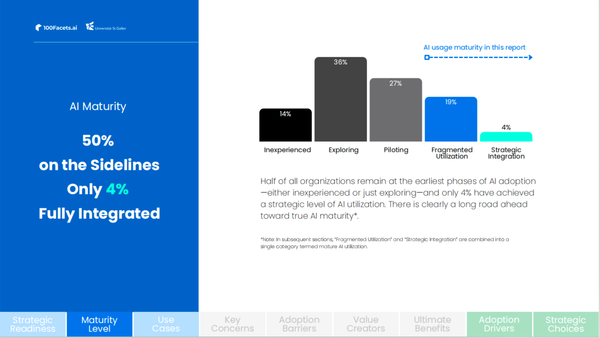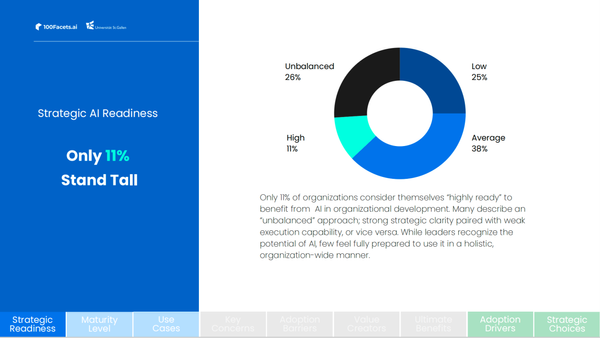Does Value Creation or Fear drive AI adoption in HR? Data shows ...

Findings of our research between 100facets.ai and University of St.Gallen (HSG) – Executive School reveals that 54% of the impetus for AI adoption in HR and L&D stems from “pull” factors—efficiency gains (26%) and effectiveness improvements (28%)—rather than push factors like top-management mandates or fear of missing out. This contrasts with the common narrative of “AI hype” driving frantic adoption.
Pull, Not Push
Push factors (e.g., employee demand, leadership pressure, or FOMO) do play a role, but their collective weight—about 46%—falls short of what truly propels AI initiatives. The data suggests that decision-makers are more motivated by tangible performance enhancements than by external or hierarchical mandates. In our panel discussions, experts stressed that genuine ROI and operational benefits tend to override hype.
Why It Matters for Implementation
- More Sustainable Adoption: When people see direct performance benefits (shorter hiring cycles, more accurate skill assessments), they’re more likely to champion AI beyond initial pilots.
- Less Resistance: If employees and managers witness clear efficacy—like real-time feedback improving daily tasks—they’re more apt to accept AI. “We don’t have to push top-down edicts,” said one OD manager.
- Focus on Practicality: Instead of implementing AI “because leadership said so,” teams prioritize solutions that solve real workflow bottlenecks. This fosters more pragmatic, measurable results.
Navigating Tensions
While pull factors often lead to better buy-in, they can cause friction when top executives want immediate large-scale AI transformations. Some of our experts pointed out that, in truly progressive organizations, leadership sets a strategic vision but leaves room for grassroots exploration—an environment where local teams adopt AI only if it authentically boosts efficiency or quality.
How to Harness the Pull
- Identify Pressing Pain Points: Before rolling out AI, find a genuine operational headache—like sluggish training completion rates or mismatched content. Solve that, and you earn trust.
- Market the Value: Celebrate early wins. If a small pilot slashes admin time by 30%, share those numbers organization-wide. This transparency fuels further pull.
- Keep Leadership Engaged, But Not Overbearing: Leaders should back AI initiatives with resources and visibility, yet resist micromanaging. The data suggests that the best AI adoption thrives under a “support but don’t shove” model.
So what?
Though “AI hype” can spark conversation, the real driver behind successful implementation is the clear, measurable uplift in everyday processes—whether it’s saving recruiters from repetitive screening or fine-tuning leadership development. Leaders eyeing AI should realize that a “pull-based” approach often beats forced mandates. When employees witness the technology solving real problems, adoption becomes less about corporate compliance and more about seizing valuable opportunities for improvement.




